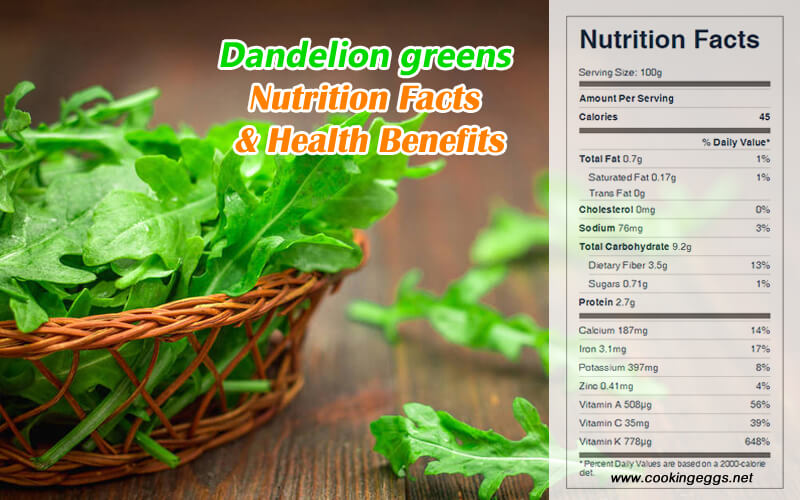Dandelion Greens Nutrition Facts & Health Benefits
Dandelions are found on six continents and have been gathered for food since prehistory. The entire plant, including the leaves, stems, flowers, and roots, is edible and nutritious, with nutrients such as vitamins A and K, as well as calcium and iron. Here are the nutritional benefits of dandelion.

Raw dandelion greens are 86% water, 9% carbohydrates, 3% protein, and 1% fat. Raw dandelion greens contain high amounts of vitamins A, C, and K, and are moderate sources of calcium, potassium, iron, and manganese.
Nutritional Composition of Dandelion
One-half cup of raw dandelion greens provides 45 calories, 9 g carbohydrate, 2.7 g protein, 0.49 g fat, 3.5 g dietary fiber, 4931 IU vitamin A, 35 mg vitamin C, 4.8 mg vitamin E, 273.7 mcg beta-carotene, 0.17 mg copper, 3.1 mg iron, 36 mg magnesium, 66 mg phosphorus, 397 mg potassium, and 76 mg sodium.
Dandelion Greens Nutrition Facts Label
Health Benefits of Dandelion Greens
Dandelion has been used in traditional medicine in Europe, North America, and China. The plant has been used in herbal medicine for a very long time, both in Europe and the East. For centuries, juice from the roots could be found at every apothecary. Analyses of dandelion have indicated a wide range of chemical substances, including terpenoids and sesquiterpene lactones.
Dandelion is also a digestive and urinary system tonic. It is also a gentle, effective diuretic, helping to eliminate uric acid, excess cholesterol, and urea. The plant supplies enough potassium to compensate for the amount lost in the urine. It is also known as a blood-cleanser and is helpful for toxic or inflammatory conditions of the skin or joints. The leaves are nearly as useful as the roots.
Dandelion is rich in calcium, which is essential for the growth and strength of bones. It is rich in antioxidants like vitamin C and luteolin, which protect bones from age-related oxidative damage. Dandelion juice is a diuretic and may stimulate insulin production. Dandelion is also used as a vegetable; it’s a good source of fiber. Dandelion greens are rich in vitamin C and are among the best vegetable sources of beta-carotene. They provide potassium, iron, calcium, magnesium, phosphorus, and the B vitamins thiamine and riboflavin, and the iron that they supply is more readily taken up by the body than the iron in spinach.
The bitter taste of dandelion leaves is a clue to their usefulness: they have a longstanding reputation for the treatment of liver problems. The young leaves, blanched or soaked in water to remove bitterness, are included in salads. To make the leaves more palatable, they are often blanched to remove bitterness or sauteed in the same way as spinach.
The leaves, too, can act as a powerful diuretic, with the added advantage that the high percentage of potassium means that some is retained in the body, although there is a considerable loss in urine. Dandelion leaves are edible in the springtime, before the plant flowers, and are high in iron and beta-carotene. The leaves also have a diuretic effect, and although most chemical diuretics deplete the body of potassium, dandelion greens, by contrast, are rich in this mineral.
Dandelion flowers contain a wide range of phytochemicals, including polyphenols like apigenin, isoquercitrin (a quercetin-like compound), and caffeic acid, as well as terpenoids, triterpenes, and sesquiterpenes. Dandelion blossoms can be separated from the calyx and sprinkled on salads. They contain lutein, a nutrient that is beneficial for the eyes.
Dandelion roots are also edible. The roots contain a substantial amount of the prebiotic fiber inulin. The root contains about 25% inulin, which could be employed to produce a high-fructose syrup. Dandelion-root tea has long been used to improve skin conditions such as acne and eczema, and also to improve liver function. Its root has been employed as a diuretic, tonic, laxative, and appetite stimulant, and to stimulate bile flow.
Health Risk
Dandelion pollen may cause allergic reactions when eaten or adverse skin reactions in sensitive individuals. Contact dermatitis after handling has also been reported, probably from the latex in the stems and leaves.
Though dandelion is generally safe and gentle, some people may have an allergic reaction to the milky latex in the stem and leaves. Dandelion root should not be taken with pharmaceutical diuretics or drugs that have a diuretic action. Diabetes patients should exercise caution when using dandelion root because it may enhance the effect of those medications in lowering blood sugar.
Individuals with allergies to daisies may wish to stay away from dandelions. The greens are also a source of oxalates, which can cause problems for those with kidney disease, gout, vulvar pain, rheumatoid arthritis, or other conditions that may require a low-oxalate diet.